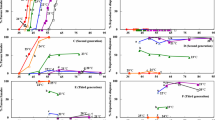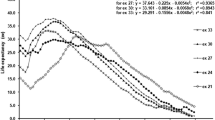Abstract
The effect of temperature on the life history characteristics of amictic females (AF), unfertilized mictic females (UMF) and fertilized mictic females (FMF) inBrachionus calyciflorus was studied with replicated individual cultures at 20°C, 25°C and 30°C, and with algaeScenedesmus obliquus for their food. There were highly significant effects of both temperature and female type, independently and interactively, on the duration of juvenile and post-reproduction periods, and the number of eggs produced by the rotifer per life cycle. Among all the temperature-female type combinations, all the juvenile periods of FMF, and the post-reproduction periods of UMF and FMF at 20°C, were the longest, and the number of eggs produced by an UMF at 30°C was the highest. There were highly significant effects of both temperature and female type on the duration of the reproduction period, but no clear correlation was observed between temperature and female type. The reproduction period of AF was longer than that of UMF and FMF. Only temperature influenced significantly the mean life-span of the three types of female. The duration of juvenile, reproduction and post-reproduction periods as well as the life-span of the three types of females were all reduced very significantly with rise of temperature, but the rates of reduction varied with female type. Among the three types of females, the number of eggs produced per life cycle by an UMF was the highest, and that of a FMF was the lowest. A significant relationship between the number of eggs produced per life cycle and temperature was observed only in the UMF.
Similar content being viewed by others
References
Awaïss, A., P. Kestemont, 1992. An investigation into the mass production of the freshwater rotiferBrachionus calyciflorus Pallas. 2. Influence of temperature on the population dynamics.Aquaculture 105: 337–344.
Bennett, W. N., M. E. Boraas, 1989. A demographic profile of the fastest growing metazoan: a strain ofBrachionus calyciflorus (Rotifera).Oikos 55: 365–369.
Carmona, M. J., M. Serra, 1991. Comparative total protein and demographic patterns of mictic and amictic female rotifers.Verh. Internat. Verein. Limnol. 24: 2754–2759.
Dahril, T., 1997. A study of the freshwater rotiferBrachionus calyciflorus in Pekanbaru, Riau, Indonesia.Hydrobiol. 358: 211–215.
Galindo, M. D., C. Guisande, 1993. The reproduction biology of mictic females inBrachionus calyciflorus Pallas.J. Plankt. Res. 15: 803–808.
Galkovskaja, G. A., 1987. Planktonic rotifers and temperature.Hydrobiol. 147: 307–317.
Gilbert, J. J., 1963. Mictic female production in the rotiferBrachionus calyciflorus.J. Exp. Zool. 153: 113–124.
Gilbert, J. J., 1977. Mictic female production in monogonont rotifers.Arch. Hydrobiol. Beih. Ergebn. Limnol. 8: 142–155.
Guisande, G., N. Mazuelog, 1991. Reproductive pattern ofBrachionus calyciflorus Pallas at different food concentrations.J. Plankton Res. 13: 279–286.
Hagiwara, A., A. Hino, R. Hirano, 1988. Effect of temperature and chlorinity on resting egg formation in the rotiferBrachionus plicatilis.Nippon Suisan Gakkaishi 54: 569–575.
Halbach, U., 1970. Einfluss der temperatur auf die Populationsdynamik des planktischen RädertieresBrachionus calyciflorus Pallas.Oecologia 4: 176–207.
Huang, X. F., 1989. Observation on the egg and post-embryonic development time of some rotifers in Lake Donghu, Wuhan.Oceanol. Limnol. Sin. 20: 184–191. (in Chinese).
King, C. E., 1970. Comparative survivorship and fecundity of mictic and amictic female rotifers.Physiol. Zool. 43: 206–212.
Li, S. H., H. Zhu, Y. Z. Xia et al., 1959. The mass culture of unicellular green algae.Acta Hydrobiol. Sin. 4: 462–472.
Pourriot, R., M. Deluzarches, 1971. Recherches sur la biologie des rotifères. Influence de la température sur la durée du développement embryonnaire et post-embryonnaire.Ann. Limnol. 7: 25–52.
Pourriot, R., 1973. Recherches sur la biologie des rotifères III, Fécondite et durée de vie comparées chez les femelles amictiques et mictiques de quelques espèces.Ann. Limnol. 9: 241–258.
Pourriot, R., C. Rougier, 1975. Dynamique d’une population expérimentale deBrachionus dimidiatus en fonction de la nourriture et la température.Ann. Limnol. 11: 125–143.
Pourriot, R., P. Clément, 1981. Action de facteurs sur la reproduction et le cycle reproducteur des rotifères.Acta Oecol., Oecol. Gen. 2: 135–151.
Pourriot, R., T. W. Snell, 1983. Resting eggs in rotifers.Hydrobiologia 104: 213–224.
Pourriot, R., C. Rougier, 1991. Importance volumétrique des ocufs chez les Rotifères planctoniques.Ann. Limnol. 27: 15–24.
Snell, T. W., 1986. Effects of temperature, salinity and food level on sexual and asexual reproduction inBrachionus plicatilis (Rotifera).Mar. Biol. 92: 157–162.
Walz, N., 1983. Individual culture and experimental population dynamics ofKeratella cochlearis (Rotatoria).Hydrobiol. 107: 35–45.
Walz, N., 1987. Comparative population dynamics of the rotifersBrachionus angularis and Keratella cochlearis.Hydrobiol. 147: 209–213.
Xi, Y. L., X. F. Huang, 2000. Effect of temperature on the experimental population dynamics ofBrachionus urceolaris.Oceanol. Limnol. Sin. 31: 23–28.
Xi, Y. L., X. F. Huang, H. J. Jin, 2001a. Life history characteristics of three types of females inBrachionus calyciflorus Pallas (Rotifera) fed different algae.Hydrobiol. 446/447: 95–98.
Xi, Y. L., X. F. Huang, H. J. Lin et al., 2001b. The effect of food concentration on the life history of three types ofBrachionus calyciflorus females.Internat. Rev. Hydrobiol. 86: 211–217.
Author information
Authors and Affiliations
Corresponding author
Additional information
Projects supported by NSFC (No. 39870158), Natural Science Foundation of Anhui Province (No. 100330: No. 042416) and the Excellent Youth Foundation (No. 04043050).
Rights and permissions
About this article
Cite this article
Yilong, X., Xiangfei, H. Temperature effect on the life history of three types ofBrachionus calyciflorus females. Chin. J. Ocean. Limnol. 22, 192–197 (2004). https://doi.org/10.1007/BF02842592
Received:
Accepted:
Issue Date:
DOI: https://doi.org/10.1007/BF02842592




